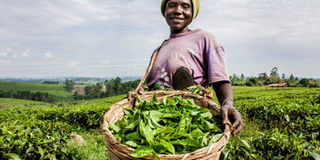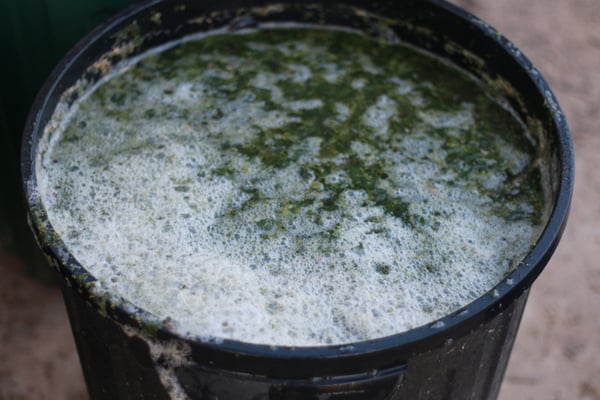Tips for growing tea on your farm

Farmers are advised to pick only mature tea from the top. Photo / Courtesy
What you need to know:
- When setting a nursery bed, farmers are expected to mix eight wheelbarrows of top soil mixture with a quarter kg of DAP for 1,200 wrapper bags which must be filled with soil mixed with fertiliser.
In Uganda most of the agricultural activities conducted on farms are done mainly by the elderly. This cuts across crop, farming, livestock keeping and poultry keeping.
Some of the agricultural activities are being carried out by corporate organisations involving the actual farming but also innovative activities where value is added to some products for further marketing including applied mechanisation on farm.
However, this trend is now being changed with agricultural experts engaging the youth to take up agriculture as an entrepreneurship initiative.
One such activity is where the Uganda National Farmers Federation jointly with National Research Agricultural Organisation (Naro) organises agricultural show at Jinja Show ground only for students from Senior One to Senior Six in schools across the country.
This year’s student’s agricultural show which ended last week drew the attention of students about the agricultural research conducted in various priority crops at Naro such as research conducted in tea production in the country.
Dr Ronald Kawooya a research officer at Rwebitaba Zonal Agricultural Research and Development and his team of scientists sensitised the students about tea farming. He told themabout the general agronomy practices and tea processing including possible value addition products which are in the offing.
Background
Dr Kawooya told the students that in the world, tea is among the most consumed popular beverages. It can be consumed as ice tea or hot tea.
There are number of tea beverage types taken by people across the world including green tea, black tea and oolong tea beverage got from camellia sinensis plant.
Tea farming was introduced in Uganda by the British in 1900 and effective tea research ended in 1977 after the breakaway of the East Africa Community.
Propagation
Tea is commercially propagated by vegetative material. Tea plants can be raised from seed, cuttings and tissue culture.
Propagation from seed is less common nowadays following development of operationally easy, rapid and cheap techniques of vegetative propagation which facilitate easy production of cultivars.
Nursery preparation
Wrapper nurseries are recommended for raising vegetative propagated materials and the factors farmers can consider in site selection include the closeness of the nursery to a permanent source of water and the availability of shelter from prevailing wind.
Availability of deep free draining soil, friable and with pH range of 5.0 and 5.6 which is considered ideal for nursery propagation. Avoidance of low lying area which becomes very wet during the rainy season. When setting a nursery bed, farmers are expected to mix eight wheelbarrows of top soil mixture with a quarter kilogramme of DAP for 1,200 wrapper bags which must be filled with soil mixed with fertiliser.
Site selection
Tea requires a climate with specific limits of certain attribute, a soil with special characters, a proper clearing and preparation of land prior to planting.
Tea once planted, could last for up to 100 years and beyond therefore requiring rainfall of 1200mm to 2200mm that is well distributed throughout the year and temperatures ranging from 13 degrees Celsius to 30 degrees Celsius.
An altitude of 1500 to 2250 metres above sea level is ideal for tea cultivation. It is ideal to plant wind break trees which must grow at a height of 10cn tall and planted 85cm apart in between the plantation.
The wind breaks help in reducing the speed of wind during times of rain thereby maintaining the soil fertility and constant moisture.
Trees recommended for windbreaks are Hakea saligna and Grevillea Robusta and tea hedges can also be used to shelter the tea bushes.
Tea does well in well in deep well‐drained red volcanic soil with soil pH range of 4 and 5.6.
Field planting
Wrapped plants are ready for transplanting when roots have reached the bottom of the wrapper and also have at least 20cm of top growth.
The plants must be handled carefully to avoid cracking and they should be stacked carefully and tightly on any vehicle taking them to the field.
The holes should be 15cm by 20 cm deeper and double their diameter, though the minimum should be 25cm. Today, tea is grown as a bush approximately one metre high, for ease of plucking. Bushes are grown from cuttings or clones which are carefully nurtured in nursery beds until ready for planting out.
Young bushes are planted approximately 1.5 metres apart in rows with a distance of one metre between each row. Farmers are advised to use 15gm Diammonium Phosphate (DA) per planting hole or 30gm of single super phosphate. Mix fertilisers thoroughly with soil from planting holes and water the planting sites.
Plucking
Tea plucking is the removal of the top most bud and tender shoots of tea for processing. This may be done by hand wielded implements or motorised mechanical plucking machine.




